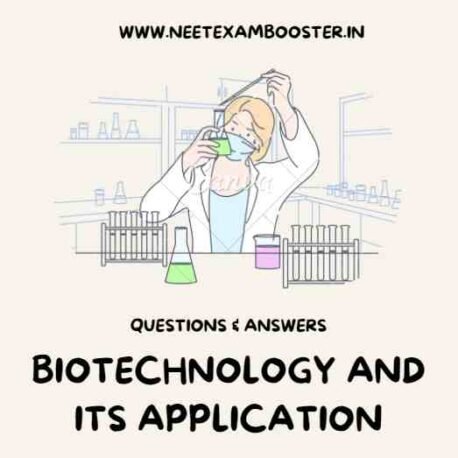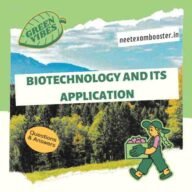Biotechnology Principles and Processes Class 12:- Biotechnology deals with the large scale of production and marketing of the products and the processes using live organisms,cells or enzymes.
Biotechnology Principles and Processes Class 12 – Very Short Answer Type Questions

Q.1. How can we say that the copy number of the plasmid vector and the yield of the recombinant protein are related to each other?
A.1. The copy number of the plasmid vector is directly related to the yield of the recombinant protein. Higher the copy number of the vector plasmid, greater is the copy number of the gene and consequently, the yield of the recombinant protein is in higher amounts.
Q.2. Can the exonuclease enzyme be used while producing the recombinant DNA molecule?
A.2. No, the exonuclease cannot be used while producing the recombinant DNA. This is due to the exonuclease degrading the DNA molecules. It cannot produce the DNA fragments with the sticky ends.
Q.3. Write the features of the plasmid being used as the cloning vector?
A.3. Following are the characteristics of the plasmids being used as a cloning vector are:
- The cloning vector must should have an origin of replication
- The cloning vector must should have a selectable marker
- The cloning vector must should have restriction sites
Q.4. Define competent cells.What is the meaning of the word “competent” ?
A.4. The Competent cells are those which allow the foreign DNA to incorporate into the host by the slight alteration in the cell walls. The “Competent” means the ability of a cell to intake the foreign DNA.
Q.5. What do you mean by “Eco”, “R” and “I” to in the enzyme EcoRI?
A.5. The word “Eco” means the species from which it is taken, “R” means to the particular strain, and “I” means that it was the first enzyme isolated from this strain.
Q.6. Why are the proteases enzyme added when we isolate the DNA?
A.6. The Proteases are added to degrade the proteins so that they do not interfere with the downstream of the DNA treatment.
Q.7. When the “denaturation” step is missed during the PCR, what will be its effect on the entire process?
A.7. When the denaturation process is missed, there will be no separation of the DNA strands, the primers will not anneal to the template strands and eventually, the amplification of the DNA will not occur.
Q.8. Write the name of a recombinant vaccine.
A.8. The Hepatitis B vaccine is a recombinant vaccine.
Biotechnology Principles and Processes Class 12 Quiz
Q.9. How can we say that the Ti plasmid of Agrobacterium tumefaciens modified to convert it into a cloning vector?
A.9. The Ti plasmid is a tumour-inducing plasmid. The genes responsible for its pathogenic nature are either they removed or altered so that it does not they harm the plants and only delivers the gene of interest.
Q.10. Do biomolecules such as the DNA, proteins exhibit the biological activity in the anhydrous conditions?
A.10. No, the biomolecules do not exhibit the biological activity in anhydrous conditions. That is why the life does not sustain without the water.
Q.11. Define Biotechnology.
A.11. Biotechnology is defined as the broad area of the biology that uses both the technology and the application of the living organisms and their components to develop, modify and to produce the useful product for the human welfare. The term ‘Biotechnology’ was coined in the year 1919 by an agricultural engineer Karoly Ereky, therefore he is known as the father of Biotechnology.
Biotechnology Principles and Processes Class 12
Q.12. Define Genetic engineering.
A.12. The Genetic engineering is the technique mainly used to change or to modify genetic material (DNA/RNA), and to introduce them into the other organisms.
Q.13.Write the Principles of the Biotechnology?
A.13.The modern biotechnology started with the two crucial technologies:
- Genetic engineering
- Chemical engineering.
Q.14.How can we say that the Biotechnology useful in the developing food crops and in the agriculture process.
A.14.The Biotechnology extends its applications over the broad spectrum in the fields of the agriculture and the development of food crops.
In the agriculture field, it helps in the improving food quality, quantity, and the processing. The Bio-fertilizers and Bio-pesticides are the eco-friendly sources for agriculture, that contains the living microorganisms which help in promoting the growth by increasing the supply or the availability of primary nutrients.The Farmers choose biotech crops to increase the yield and in the lower production costs.
Q.15.Write the different types of biotechnology.
A15.The scope of the Biotechnology has driven a need to classify the Biotech based on some common features or the final purpose.
Following are the types of the biotechnology:
- Food Biotechnology.
- Medical Biotechnology
- Agricultural Biotechnology.
- Marine Biotechnology
- Plant Biotechnology.
- Animal Biotechnology.
- Environmental Biotechnology.
- Industrial Biotechnology.
- Bio-process engineers.
- Biopharma.
Biotechnology Principles and Processes Class 12 – Short Answer Type Questions
Q.1. What do you meant by the gene cloning?
A.1. The Gene cloning or the DNA cloning is the process in that the gene of the interest is copied out of the DNA extracted from an organism. The process of the gene cloning is carried out in the following steps:
Isolation of the DNA fragment or the gene
↓
Then Selection of the appropriate vector
↓
Isolated DNA fragment is incorporated into the vector
↓
Recombinant vector is transformed in the host cell
↓
Finally the recombinant host cell is isolated.
Q.2.The gene was being ligated to the plasmid vector to prepare the recombinant DNA during the bacterial transformation. An exonuclease enzyme was added to the tube accidentally. How it affect the next step of the experiment?
A.2. There will be no effect on the experiment. It is due to a recombinant DNA is circular and closed with the no free ends. Henc , the exonuclease will not be degrade the DNA.
Q.3. What happen if the restriction enzymes do not cut the DNA at the specific recognition sequences?
A.3. If restriction enzymes do not cut the DNA at the specific sites, the DNA fragment obtained will not have the sticky ends, and therefore the construction of the recombinant DNA would be difficult.
Q.4. How can the DNA viewed on an agarose gel?
A.4. The DNA is stained with the ethidium bromide that intercalates with the DNA strands and gives orange bands on the exposure to the ultra-violet light. So one can view the DNA on an agarose gel.
Q.5. What happen when the plasmid without a selectable marker was chosen as a cloning vector?
A.5. The selectable marker helps to distinguish the transformed cells from the non-transformed ones. If cloning vector do not have a selectable, marker, it will be difficult to select the transformants.
Biotechnology Principles and Processes Class 12
Q.6. How can we say that the competent cells are prepared by the action of the CaCl2?
A.6. The divalent calcium ions create the pores in the cell wall of the bacteria and it will facilitate the uptake of the foreign DNA by the bacterial cell.
Q.7. The mixture of fragmented DNA was run into an agarose gel. The gel was stained with the ethidium bromide but here no bands were observed. What is the cause for this?
A.8. Following are the reason:
- DNA must have degraded by the nucleases.
- Electrodes are placed in the opposite direction in gel assembly. Consequently, the DNA molecules move outside of the gel.
- Maybe the ethidium bromide was not added sufficiently and therefore the DNA was not visible.
Biotechnology Principles and Processes Class 12 – Long Answer Type Questions
Q.1. Write the role of the Agrobacterium tumefaciens in the plant transformation?
A.1. The Agrobacterium tumefaciens is the plant pathogen that infects the crops such as the tomato, sunflower, cotton, soybean, etc. It causes the crown gall disease in the plants which are induced by the Ti plasmid or the tumour-inducing plasmid. The Ti plasmid incorporates the DNA segment called the T-DNA into the DNA of the host plant cell. This T-DNA causes the tumours.
Q.2. Define a bioreactor.Write its different types of the bioreactors.
A.2. The bioreactor is a large vessel used to carry out the biological reaction and to culture the aerobic cells for conducting the cellular or enzymatic immobilizations. Following are the different types of bioreactors are:
- Stirred Tank Bioreactors
- Bubble Column Bioreactors
- Airlift Bioreactors
- Fluidized Bed Bioreactors
- Packed Bed Bioreactors
Q.3. Define polymerase chain reaction. Write the steps involved in it. Write its applications.
A.3. Polymerase chain reaction is the process used in the molecular biology to obtain the several copies of a specific segment of DNA.
Following are the steps involved in the process:
- Denaturation
- Annealing
- Extension
Applications:
Following are the application :
- Forensic Science
- Research and genetics
- Medicine
Biotechnology Principles and Processes Class 12
Q.4. Write the properties of a good vector.
A.4. Following are the properties of the good vector :
- The vector must be small in size so that it is easy to isolate and to purify.
- It should have an origin of the replication, a base pair sequence where the replication starts.
- It should have the selectable marker which helps in selecting the transformed the host cells.
- The vector should have at least one of the unique recognition site to bind the foreign DNA.
Q.5. Write any three vector-less methods in which are used to introduce the recombinant DNA into a competent host cell.
A.5. Following are the three vector-less methods include:
- Transformation: It is the process in that bacteria take up the genetic material directly from the surroundings. For this process,the bacterial cells are treated with the calcium chloride. The cells are then incubated in the ice and then the subjected to very high temperatures. Which creates the pores in the bacterial cell wall and foreign DNA is taken up by the bacterial cell.
- Microinjection: It is the recombinant DNA that is directly injected into the nucleus of an animal cell with the help of the microneedle.
- Biolistics/Gene gun Method: The cells that are bombarded with the very high-velocity microparticles of the gold and tungsten coated DNA.
Click here to join our telegram channel for more important questions and answers like this Biotechnology Principles and Processes Class 12.



















